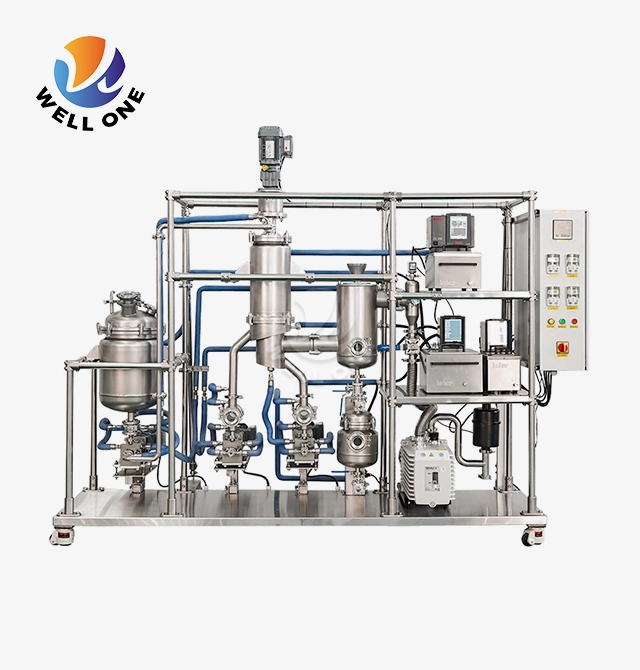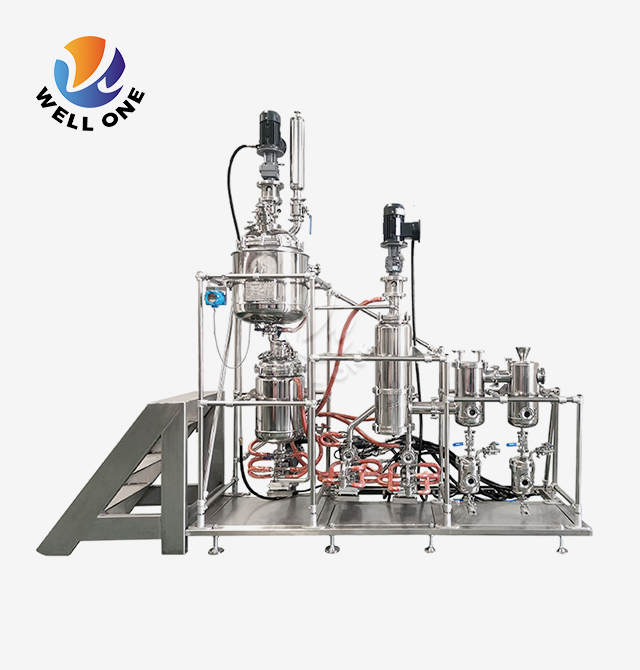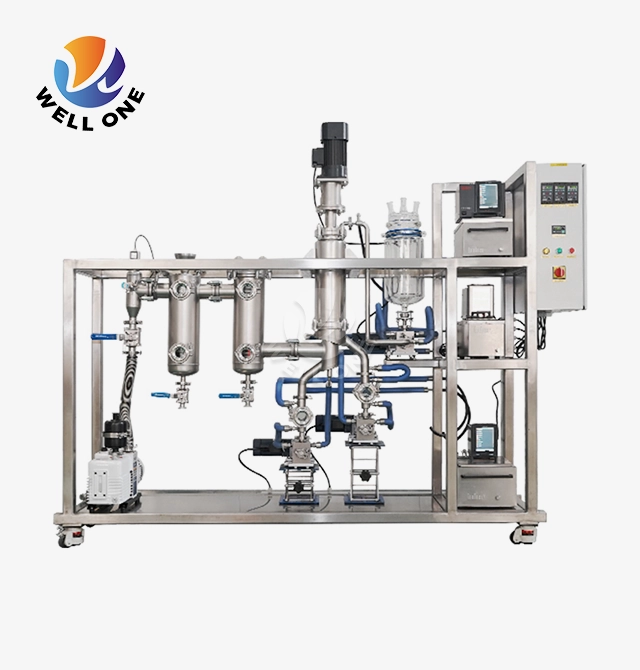Why Use A Dual Stage Wiped Film Distillation?
Wiped film distillation is an important industrial separation technique widely used for purifying thermally sensitive and high boiling point chemical compounds. It involves the thin film evaporation principle to efficiently isolate distillates of exceptional purity from complex mixtures. Dual stage wiped film distillation takes this separation process a step further by carrying out the distillation in two sequential stages.
This dual configuration offers significant advantages over single stage wiped film distillation and other conventional distillation methods. The two-step approach allows for superior separation efficiency, lower energy use, higher throughput, and ultrapure distillate products unattainable in a single pass unit.
In this article, we will explore what dual stage wiped film distillation is, its working principle and design, the key benefits it provides, practical applications across different industries, and factors influencing its performance and maintenance requirements. The objective is to demonstrate why employing a dual stage wiped film distillation system is advantageous for high-purity distillate isolation from difficult mixtures.
Understanding Dual Stage Wiped Film Distillation
Dual stage wiped film distillation involves carrying out the distillation process in two wiped film evaporator units connected in series. The feed mixture is first partially separated in the first stage unit, with the distillate vapor condensed and collected separately. The undistilled residual mixture from the first stage is then fed into the second stage for further separation and purification.
The distinguishing components of a wiped film distillation system are the heated vertical evaporator shells, internal rotor assemblies, and scraper blades. The feed mixture is introduced onto the rotating scraper blades that spread it into a thin film on the heated internal surfaces. The intimate contact facilitates rapid and gentle evaporation of the volatile components from the film into vapor.
The key advantages of dual stage distillation are the abilities to handle more complex mixtures, achieve purer distillates, prevent product degradation, and improve energy efficiency compared to single stage systems. The two-step separation also allows selective isolation of different distillate fractions in each stage.
Dual stage wiped film distillation is therefore well-suited for applications involving heat sensitive materials, very high boiling fractions, and difficult separations requiring multiple vapor-liquid equilibria. Industries utilizing this technology include pharmaceuticals, fine chemicals, food processing, fragrances, and petrochemicals.
Benefits of Dual Stage Wiped Film Distillation
The major benefits provided by dual stage wiped film distillation can be summarized as follows:
Enhanced Separation and Purification Capabilities
The two-step distillation process allows better separation of complex mixtures and close boiling fractions unattainable in a single stage. It also enables selective fractionation of distillates with different properties in each stage. Overall, this results in extremely high purity products free of contaminants and trace impurities.
Reduced Energy Consumption and Operating Costs
By dividing the evaporation duty over two stages, the thermal efficiency of the process improves significantly. The lower vapor loads in each stage reduce energy requirements for heating and condensation. More gentle operating conditions also lead to lower maintenance costs.
Increased Throughput and Scalability
Dual stage systems offer higher throughput capacities essential for large scale industrial applications. The modular configuration also allows easy expansion of production volumes through parallel trains or larger equipment.
Improved Distillate Purity and Yield
The stepwise separation gives better fractionation, low volatility components stay behind while high volatility fractions are isolated in purer form. This enhances distillate purity while also improving yields.
Dual Stage Wiped Film Distillation in Practice
Pharmaceutical Purification
Dual stage wiped film distillation is commonly employed in pharmaceutical manufacturing for purifying antibiotics, steroids, alkaloids, vitamins, and APIs from fermentation broths and synthetic reactions. The mild operating conditions prevent degradation while removing impurities and residual solvents to ppm levels.
Natural Oil Processing
Edible oils contain many Minor components alongside the triglycerides that affect taste, odor, and appearance. Dual stage wiped film distillation allows selective fractionation of these high value volatile minor components from crude vegetable oils for food and cosmetic applications.
Chemical Purification
Specialty chemicals like surfactants, organic acids, polymers, and waxes containing impurities and high boilers are purified using dual stage wiped film distillation. The systems can handle a wide range of temperatures, viscosities, and chemistries.
In contrast to conventional distillation, wiped film evaporators prevent local overheating, cracking, charring, and fractionation constraints. They can unzip azeotropes and separate thermally sensitive materials without product degradation.
Petrochemical Refining
Dual stage wiped film distillation enables separation of high value fractions from crude oil streams that are difficult to distill conventionally. Specialty hydrocarbon cuts, lube oils, and diesel fuel additives are purified using this technology.
Factors Influencing Performance of Dual Stage Wiped Film Distillation
Several equipment design and operating parameters influence the performance of a dual stage wiped film distillation system. These include:
Feed Material Composition
Feed mixtures with a high concentration of volatile components are more easily separated. Higher viscosity feeds require specific equipment configurations to maintain proper film formation and flow.
Temperature Control
Precise temperature control across different zones ensures optimal driving force for evaporation while preventing thermal degradation. Gradual heating is essential for heat sensitive feeds.
Pressure Control
The operating pressure impacts volatility and boiling points. Reduced pressures accelerate evaporation while minimizing temperature requirements. Vacuum operation provides highest purity distillates.
Film Formation and Flow
Proper design of rotor and scraper blades is crucial for uniform film formation and surface wetting in the evaporators. This ensures efficient contact and mass transfer.
Residence Time Distribution
Sufficient residence time must be allowed in each stage for completing the evaporation while preventing fractionation issues. Optimized design maximizes throughput.
Equipment Selection and Configuration
Appropriate selection of wiped film evaporator type, material of construction, stage configuration, and ancillary equipment determines performance.
Maintenance and Care of Dual Stage Wiped Film Distillation Setup
To sustain consistent high performance, dual stage wiped film distillation systems require diligent maintenance procedures including:
- Routinely inspecting equipment for leaks, damage, blockages, loose parts.
- Cleaning evaporator internals and condensers to prevent fouling or clogging.
- Replacing worn out scraper blades, shaft seals, and other parts.
- Checking electrical, heating, and rotating elements for proper functioning.
- Confirming pumps, valves, and lines have no issues.
- Monitoring and calibrating temperature sensors and pressure gauges.
- Keeping accurate logs of run hours, throughput, energy use for optimization.
- Scheduling preventive maintenance during plant shutdowns.
- Establishing SOPs for operation, troubleshooting, inspection, cleaning protocols.
- Ensuring operators are properly trained on equipment safety, start up, shutdown, and responses to abnormal conditions.
With conscientious maintenance and operation practices, dual stage wiped film distillation systems will deliver consistent long-term performance safely and profitably.
Wrapping Up
Dual stage wiped film distillation provides significant advantages over conventional single stage distillation for separating complex mixtures and purifying high value products to the highest purity levels.
The two-step configuration enhances separation efficiency, yields ultra-pure distillates free of trace contaminants, lowers energy requirements, prevents product degradation, and improves process economics for scale up.
With a sound understanding of the technique and careful consideration of design and operating parameters, dual stage wiped film distillation can be a powerful separation tool for critical applications across pharmaceutical, chemical, petrochemical, and food processing industries.
Xi'an Well One Chemical Technology Co., Ltd takes pride in offering a top-quality Dual Stage Wiped Film Distillation system that has garnered widespread acclaim from our satisfied customers. With its wide range of applications and guaranteed quality, this product stands out as a reliable choice for various industrial needs. Our 17 years of production and manufacturing experience enable us to provide exemplary OEM and ODM services, allowing us to tailor the appearance design to meet the unique requirements of our users. Additionally, our team of skilled 3D design engineers can create captivating 3D animation designs to further enhance user experience. As an exclusive export agency authorized by NewSet since 2006, we are committed to delivering exceptional service, focusing on offering a range of products such as experimental level molecular distillation devices, pilot level molecular distillation devices, industrial level molecular distillation devices, and multi-level continuous use systems. For more details and parameters about our Dual Stage Wiped Film Distillation system, we encourage you to reach out to our professional team via Mobile: (+86) 18191320360 or Email: info@welloneupe.com. We are dedicated to providing outstanding service and are ready to address any questions you may have.
References
1. Pope, J.M. (1978). Theory and Practice of Wiped Film Distillation. AIChE Symposium Series. 74(173), 136–142.
2. Eslamimanesh, A., Hatami, T., Towfighi, J., & Mohammadi, A. (2012). Mathematical modeling and process optimization of a dual-stage Separation system based on thin film distillation. Chemical Engineering Research and Design. 90(7), 915–927.
3. Adam, F., Appell, H.R., Fu, T.T., & Watson, C.C. (1997). Practical Experience with a 20 mm Diameter Short Path Distillation Column for Laboratory and Pilot Plant Applications. Organic Process Research & Development. 1(1), 72–75.
4. Silva, C.C., Mansur, C.R.E., Lucas, E.F., & González, G. (2012). Modeling and simulation of Petrochemical Processes using a continuous separation process simulator. Computers & Chemical Engineering. 43, 99–107.
5. Lévêque, J.-M. (2007). Wiped film molecular distillation of edible oils. Lipid Technology. 19(7), 155–158.
6. Franchi, P., Curiè, C., & Rivière, J. (1991). Vacuum generators for wiped film molecular distillation. Industrial & Engineering Chemistry Research. 30(12), 2506–2510.
7. Espinosa, S., Fornari, T., Bottini, S.B., & Brignole, E.A. (2002). A design strategy for multicomponent vegetable oil refining using short-path distillation. Chemical Engineering and Processing: Process Intensification. 41(3), 239–244.
8. Peng, G., Hwang, T., & Ou, B. (1991). Removal of H2S and NH3 from low quality gases by short-path distillation. Industrial & Engineering Chemistry Research. 30(9), 2096–2103.
9. Babcock, W.C., Mayfield, F.D., & Pancost, R.W. (1952). Distillation in wiped film evaporators. Industrial & Engineering Chemistry. 44(8), 1839–1846.
10. Sage, A.B., Lund, D.B., & Pace, G.W. (1967). Liquid distribution in wiped film evaporators. Industrial & Engineering Chemistry Process Design and Development. 6(1), 53–57.







